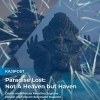Socio-Economic Life on Pramuka Island, Thousand Islands and Its Tourism Potential: A Labor Law Perspective
Author: Usman Arifin M, SH, MH
Labor Law Consultant -- Alumnus of the Master of Law Program, Labor Law Specialization, Faculty of Law, University of Indonesia
Abstract, this study examines the dynamics of the socio-economic life of the community on Pramuka Island, part of the Thousand Islands administrative regency, and the potential of its tourism sector from the perspective of labor law. Although tourism has become the backbone of the local economy, labor regulations have not fully accommodated the needs of workers in the informal sector, such as tour guides, homestay operators, and fishers. Using a descriptive qualitative approach, data were collected through literature review and semi-structured interviews. The findings highlight the urgency of formulating local labor policies based on tourism zoning, aimed at ensuring the rights of informal workers and supporting sustainable economic development in island regions.
Keywords: Pramuka Island, tourism, labor law, informal workers, Thousand Islands
Introduction, school holidays represent a much-anticipated period in which time and the desire to vacation align, offering an opportunity for workers---often burdened by their daily routines---to spend quality time with their families. For this particular holiday, the destination chosen was a location not far from Jakarta, yet markedly different in lifestyle and enriched with marine educational experiences. Pramuka Island, located within the Thousand Islands and part of the Jakarta administrative region, serves not only as a tourism site but also as the regency capital. The name "Pramuka" (meaning "Scout") stems from the frequent scouting activities held on the island before the establishment of the Cibubur Scout Camp in Jakarta. These training sessions occurred between the 1950s and 1970s.
During the Old Order era, the island was known as Pulau Lang or Pulau Elang (Eagle Island) due to the abundance of brahminy kites (Haliastur indus), a species now symbolizing the Special Capital Region of Jakarta. These birds gradually disappeared as the island underwent urban development. As the administrative center of the Thousand Islands, Pramuka Island plays a crucial role in the growth of Jakarta's marine tourism. The local economy is largely supported by the tourism, fisheries, and related service sectors. However, most workers in these sectors remain informal and lack adequate legal protection. This research seeks to assess local labor conditions and explore tourism potential as a basis for formulating labor protection policies.
Demographically, the island's permanent residents predominantly belong to the Betawi, Bugis, Bantenese, Madurese, and Minangkabau ethnic groups. Approximately 99.8% of residents identify as Muslim, with a small minority adhering to Catholicism and other religions. The island is accessible by traditional motorboats from Kali Adem Port in Muara Angke, Kapuk Muara Subdistrict, or by speedboat from Marina Ancol in Taman Impian Jaya Ancol. Inter-island travel within the Thousand Islands can be arranged via small chartered boats (ojek perahu), connecting Pramuka to nearby islands such as Panggang, Karya, and Semak Daun.
Literature Review
1 Socio-Economic Life on Pramuka Island
Setiyanti and Sadono (2011) indicate that tourism has positively influenced local income. However, most employment remains informal, involving roles such as homestay operators and tour guides.
2 Marine Tourism Potential
Pramuka Island offers educational turtle conservation tourism, snorkeling, diving, and conservation tours. Sarma et al. (2022) highlight these assets as foundational for sustainable ecotourism development.







